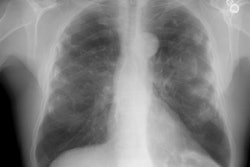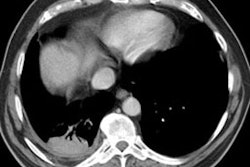J Thorac Imaging 1997 Jan;12(1):54-58. Evaluation of the reliability of computed tomographic criteria used in the diagnosis of round atelectasis.
O'Donovan PB, Schenk M, Lim K, Obuchowski N, Stoller JK
The purpose of this controlled study was to determine the diagnostic accuracy of computed tomography (CT) in the diagnosis of round atelectasis (RA). We reviewed two groups of chest CT scans of 22 patients (with 24 masses). Group 1 scans represent 10 patients (12 masses) known to have RA, and Group 2 scans represent 12 patients with "RA look-alike" masses. Scans in both groups were selected for review by two of the authors and later independently reviewed by the other authors, who were blind to the actual diagnosis. Scans were rated for the presence/absence of 18 features ascribed to RA in the literature and assigned a percent probability of RA by each rater. Consensus was achieved for discordant ratings, and the individual percent probabilities were averaged to create a consensus probability. ROC curve analysis of the consensus percent probability showed that diagnostic accuracy significantly exceeded chance [area under curve (AUC) = 0.95, p < 0.001]. Of all the features of RA examined, the presence of converging bronchovascular markings discriminated best between RA and "RA look-alikes" (sensitivity 83%, specificity 92%, likelihood ratio 11). Presence of adjacent pleural thickening and pleural-based location were even more sensitive features of RA (100% each), but lacked specificity (33 and 67%, respectively; likelihood ratios 3 and 1.5, respectively). We conclude that (a) although the diagnostic accuracy of CT for RA was high in this series, radiographic diagnosis is imperfect and that (b) the presence of converging bronchovascular markings was the best discriminator between the two groups, but that no single CT feature permitted perfect discrimination.
PMID: 8989760, MUID: 97143749




